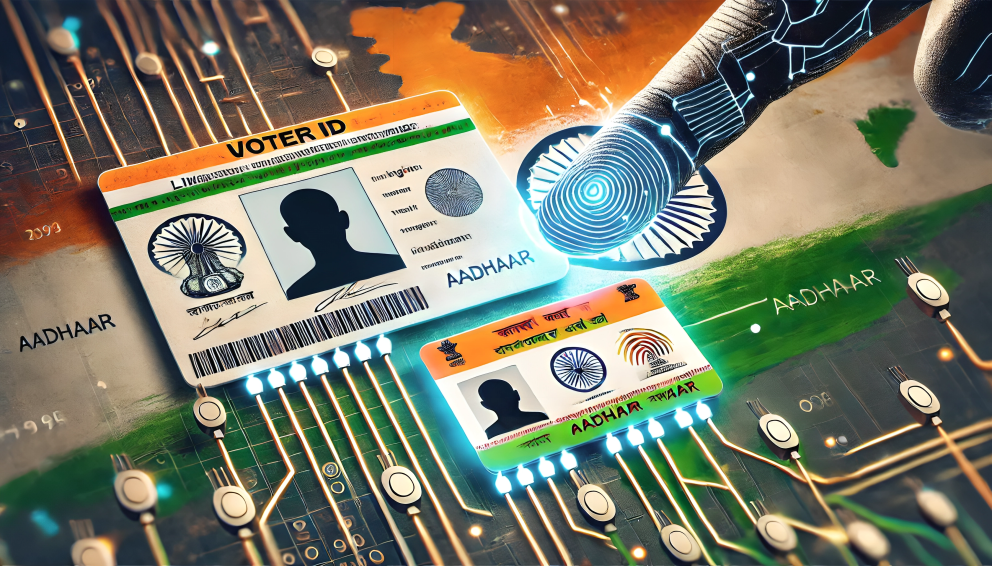Linking Voter IDs with Aadhaar


News:
Recently, on January 3, 2025, the Government of India initiated a campaign to link Aadhaar with Voter IDs to enhance the integrity of the electoral process. This initiative aims to address discrepancies in the voter system and prevent fraudulent activities during elections.
Arguments in Favor of Linking Voter IDs with Aadhaar:
Eliminating Duplicate Voter Registrations:
- Linking Aadhaar ensures that no individual is registered multiple times, reducing the chances of duplicate voting. Aadhaar’s unique ID prevents the issuance of multiple voter IDs to one person, making the process more secure. This also strengthens the system by ensuring that voter data is accurate and not manipulated.
- Example: In Uttar Pradesh during the 2019 elections, it was found that multiple voter IDs were issued to the same individuals across different constituencies. Linking Aadhaar would have helped clean the voter rolls and ensure only one registration per individual.
Increased Transparency:
- Linking Aadhaar with voter IDs eliminates electoral roll manipulation and builds public trust by ensuring only legitimate voters can vote, addressing concerns of rigging and ghost voters. This will contribute to a more transparent electoral system by making the entire voting process more credible and accountable to the public.
- Example: In West Bengal’s 2014 elections, allegations of ghost voters were raised, with many voters listed in constituencies where they had never lived. Linking Aadhaar would have ensured voter authenticity and removed such inconsistencies.
Prevention of Proxy Voting:
- Aadhaar’s biometric verification (fingerprints, iris scans) can stop proxy voting, ensuring the registered voter casts the vote. This strengthens the integrity of the voting process and prevents impersonation, providing an added layer of security during elections.
- Example: Proxy voting was reported in the 2017 Uttar Pradesh Assembly elections, where individuals voted on behalf of others. Aadhaar-based authentication would have prevented such fraudulent practices by ensuring only the registered voter could vote.
Cleaner Electoral Rolls:
- Aadhaar helps remove deceased or unqualified individuals from the electoral rolls, keeping them accurate and up-to-date. This ensures that only eligible voters appear in the electoral list, further improving the system by eliminating outdated and incorrect data.
- Example: In several Indian states, such as Bihar, voter lists contained deceased individuals who were still marked as active voters, causing discrepancies. The Aadhaar database could be cross-checked to ensure accurate and current rolls.
Cost-Effective:
- Using Aadhaar for voter ID verification avoids the need for additional infrastructure, leveraging existing biometric data for efficient elections. This approach minimizes the financial burden on the Election Commission and the government while simplifying the entire verification process.
- Example: The Election Commission of India can utilize the existing Aadhaar infrastructure without needing to create a new system, saving costs. The integration would streamline voter verification and ensure faster and more efficient elections.
Arguments Against Linking Voter IDs with Aadhaar:
Privacy Concerns:
- Linking Aadhaar to voter IDs raises concerns about the misuse of personal data, which could be exposed to political entities or hackers, compromising voter privacy. This could lead to unwanted surveillance or targeted harassment, and the centralization of personal data may further exacerbate these risks.
- Example: In 2018, a significant data breach exposed Aadhaar information of over 1.1 billion Indians, leading to fears of identity theft. If voter ID data were linked, it could heighten the risk of such breaches and misuse.
Exclusion of Eligible Voters:
- Not everyone has an Aadhaar card, especially marginalized groups, which could disenfranchise voters who may be unable to link their Aadhaar with voter IDs. This could lead to significant voter suppression, particularly affecting elderly citizens and those in rural areas who may face challenges in accessing Aadhaar enrollment centers.
- Example: In rural areas of India, many elderly citizens still lack Aadhaar cards, and they may be excluded from voting due to difficulties in obtaining an Aadhaar card, undermining their fundamental right to vote.
Security Issues:
- Centralizing voter ID and Aadhaar data raises the risk of cyber-attacks and data breaches, compromising electoral security. A successful breach could undermine the integrity of the entire election process, as hackers could manipulate or steal sensitive personal information.
- Example: The Aadhaar system has faced numerous security challenges, including the data leak that occurred in 2017, where personal information was made publicly available. If voter data were added to the database, it could escalate the risk of large-scale breaches.
Not a Solution to Electoral Fraud:
- While Aadhaar can help prevent duplicate voter IDs, it cannot address other types of electoral fraud like booth capturing, vote manipulation, or unfair practices within the election process. These are systemic issues that require deeper reforms and legal oversight, not just technological solutions.
- Example: During the 2015 Bihar elections, booth capturing by political parties was widespread. Linking Aadhaar cannot prevent these practices, as they involve physical or procedural violations that require legal and administrative interventions, not just technological solutions.
Unintended Consequences:
- Linking Aadhaar to voter IDs could lead to unintended consequences, such as political parties misusing this data for targeted, biased campaigning, undermining the fairness of elections. This could also lead to the exploitation of specific groups based on their voting behaviors, further polarizing the electorate and diminishing the integrity of democratic processes.
- Example: In the 2019 general elections, several reports indicated how political parties used data analytics to micro-target voters. Linking Aadhaar could increase this practice, giving parties more access to personal information for politically motivated campaigns.
Conclusion:
Linking Aadhaar with voter IDs could improve electoral transparency and reduce fraud, but it also raises concerns about privacy, data security, and the exclusion of legitimate voters. While it offers efficiency and accuracy, it must be implemented with proper safeguards to ensure fairness and inclusivity, protecting both the integrity of the electoral process and citizens’ rights.